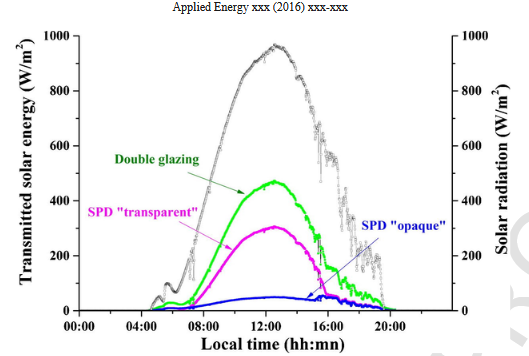ABSTRACT:
Suspended particle device (SPD) switch able glazing has potential to control transmission of solar radiation in the visible range by changing its transparency from 55% to 5%. Out door test cell characterisation of a SPD switch able glazing of fered the dynamic solar heat gain coefficient(SHGC) which varied between 0.05 (when opaque) and 0.38(when transparent).
Reduction of maximum temperature rise of 11% and 15% was possible using SPD “transparent” and “opaque” state compared to same area double-glazing. Insulated test cell with water flow heat exchanger was employed to measure the cooling load reduction potential of SPD glazing while its transmission changed from “transparent” to “opaque” state.
A cooling load reduction up to 6kWh for a 0.343m 3 volume test cell was possible by changing a 0.21m × 0.28m SPD glazing transparency from “transparent” to “opaque”. Average over all heat transfer coefficient of SPD glazing varied between 5.02W/m 2K and5.2W/m 2K for two different state.
METHODOLOGY
Outdoor test cell is an appropriate apparatus for the dynamic performance valuation for glazings. In this experiment, a test cell was equipped with a water flow heat exchange to maintain the test cell temperature at a human comfort level.
System description:
Two identical 0.7 m wide, 0.7 m deep and 0.7 m high test cells were insulated with inside surfaces composed of 0.10m thick polystyrene material. The active area of both SPD glazing and double-glazing was 0.0588 m 2. The ratio of south facing test cell and glazing area was 8:1. 0.45m long and 0.05m diameter copper coil heat exchangers pipe was placed for both test cells. Water flow was controlled using ultra sonic flow meter.
Glazing transmission:
Measured transmission spectra for SPD glazing in “opaque” and transparent” states and for double glazing using AvaSpec-UL-S2048L Star Line Versa tile Fiber-optic Spectrometer.
CALCULATIONS OF GLAZING PROPERTIES
Dynamic solar heat gain coefficients:
For vertical surface glazing, direct solar radiation incident to the glazing surface at oblique incidence angles at which the transmittance is different from the near-normal values. This angular behaviour of (global solar transmittance through glazing) was calculated from as given in Eq.(3).
Overall heat transfer coefficients:
To calculate over all heat transfer coefficient, following assumptions were made:
- Measurements were made while the vacuum glazing was in thermal
steady state. - Ground reflected solar radiation was assumed to be zero.
- The test cell was made of homogeneous highly insulating materials.
RESULTS AND DISCUSSION
Measurement without heat removal from the test cell:
Fig.5 shows the solar energy transmitted through the SPD in “transparent ” and “opaque” states and through double-glazing for a typical sunny day in Dublin.The maximum energy transmitted through the double-glazing, SPD “transparent” and SPD “opaque” nearly at 12:00 noon were 520W/m2, 410W/m2, 50W/m2 respectively.
Measurement with heat removal from the test cell:
The temperature difference of water in and out of the test cell for double-glazing SPD “transparent” and “opaque” states. The water mass flow rate was constant 0.016kg/s for all three cases. Maximum temperature difference of water inlet and outlet for double-glazing was 3°C while for SPD “transparent” was 2.4°C and “opaque” was 0.8°C.
CONCLUSIONS
Cooling load reduction potential of suspended particle device (SPD) glazing from “transparent” state to “opaque” state was investigated using an outdoor test cell integrated with one copper coil water flow heat exchanger. With out heat removal, maximum test cell temperatures were 35°C and 39°C for SPD glazing “opaque” and “transparent” states.
Variable solar heat gain coefficient from 0.05 to 0.38 was achieved using SPD switch able glazing. A 0.016 kg/s constant water mass flow rate through heat exchanger reduced the internal test cell temperatures to 25°C and 22°C for SPD “transparent” and SPD “opaque ”
For the particular test cell, reduction of coolling opaque state was 6kWh. Over all heat transfer coefficient of SPD glazing when “transparent” and when “opaque” state were 5.2W/m2K and 5.02W/m2 K respectively. Variable switch ability of SPD glazing is advantageous for building application as cooling demand of building also vary through out the day.
Source: Dublin Institute of Technology
Authors: Aritra Ghosh | Brian Norton | Aidan Duffy

